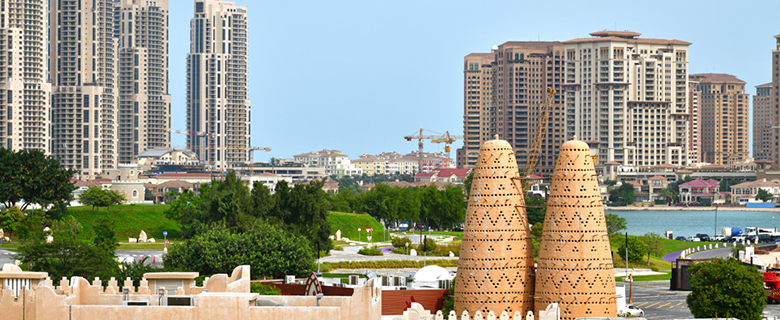
This blog post is part of a series of blog posts written on the occasion of Qatar National Day. Read the first post here and the second one here.
Qatar is one of the fastest growing countries in the world, mainly in architecture. There are photos that can prove that, showing Qatar in the past and present. Even though Qatar has changed a lot, it still bases its buildings around culture and history. Qatar’s architecture shows its history, milestones and culture. In the early 1980’s, Qatar only had one building. in Doha, which was the Sheraton Hotel. Many more buildings, with newer and better architecture, have been built since then. Al Wajba Fort is one of the buildings that show what old houses looked like. Architects nowadays base their buildings on these old traditional buildings, seen in Katara and Souq Waqif. This shows how Qataris love their history and tradition by using the same older ideas of architecture on the new buildings.
Qatar’s architecture also reflects the milestones it has reached. The 2030 Vision shows how Qatar’s architecture has improved and will continue to improve in the future. “During the reign of His Highness Sheikh Hamad bin Khalifa Al Thani, the Father Emir, May God Protect Him, Qatar National Vision 2030 has been launched to serve as a clear roadmap for Qatar’s future” (Qatar National Vision 2030). The 2030 Vision aims to improve Qatar in many different ways:
“It aims to propel Qatar forward by balancing the accomplishments that achieve
economic growth with human and natural resources. This vision constitutes a beacon that
guides economic, social, human and environmental development of the country in the coming decades, so that it is inclusive and helpful for the citizens and residents of Qatar in various aspects of their lives.” (Qatar National Vision 2030)
Qatar’s architecture is largely based on culture and through it, people can learn about Qatari culture. It is imperative to include traditional elements in the way that buildings function, such as creating courtyards and considering building orientation vis-à-vis the sun. These are basic elements that were passed down by those who lived in Qatar in much harder times without technology. They are referred to as the “old Builders" (Ibrahim Jaidah). Traditional buildings have the same features, the same brownish colors and a lot of open areas in the house to keep it cool in the summer.
Through architecture, Qatar has hit milestones, and shown people its history and culture. The 2030 Vision is set to make Qatar one of the fastest growing countries in the world. Qatar loves its history and culture, and using historical ideas on newer buildings to showcase this to people.
Works Cited:

Add new comment